Corporate Finance Report: Investment Appraisal and Valuation
VerifiedAdded on 2020/01/07
|13
|4694
|23
Report
AI Summary
This corporate finance report analyzes investment appraisal techniques and company valuation methods. Task 1 focuses on Daffodi Railways, evaluating potential franchise bids using Net Present Value (NPV) and payback period, recommending the optimal bid price based on financial analysis. Task 2 applies corporate finance theories to Wannabe Inc., computing P/E ratios, market capitalization, and enterprise value from 2011 to 2015, and explores the relationship between these metrics. The report also examines the Enterprise Value to EBITDA ratio and its implications. Task 3 evaluates the usefulness of different valuation methods used by venture capital firms and discusses the Enron Scandal. The report concludes by summarizing the findings and providing recommendations based on the financial analysis.

[Corporate finance]
Paraphrase This Document
Need a fresh take? Get an instant paraphrase of this document with our AI Paraphraser
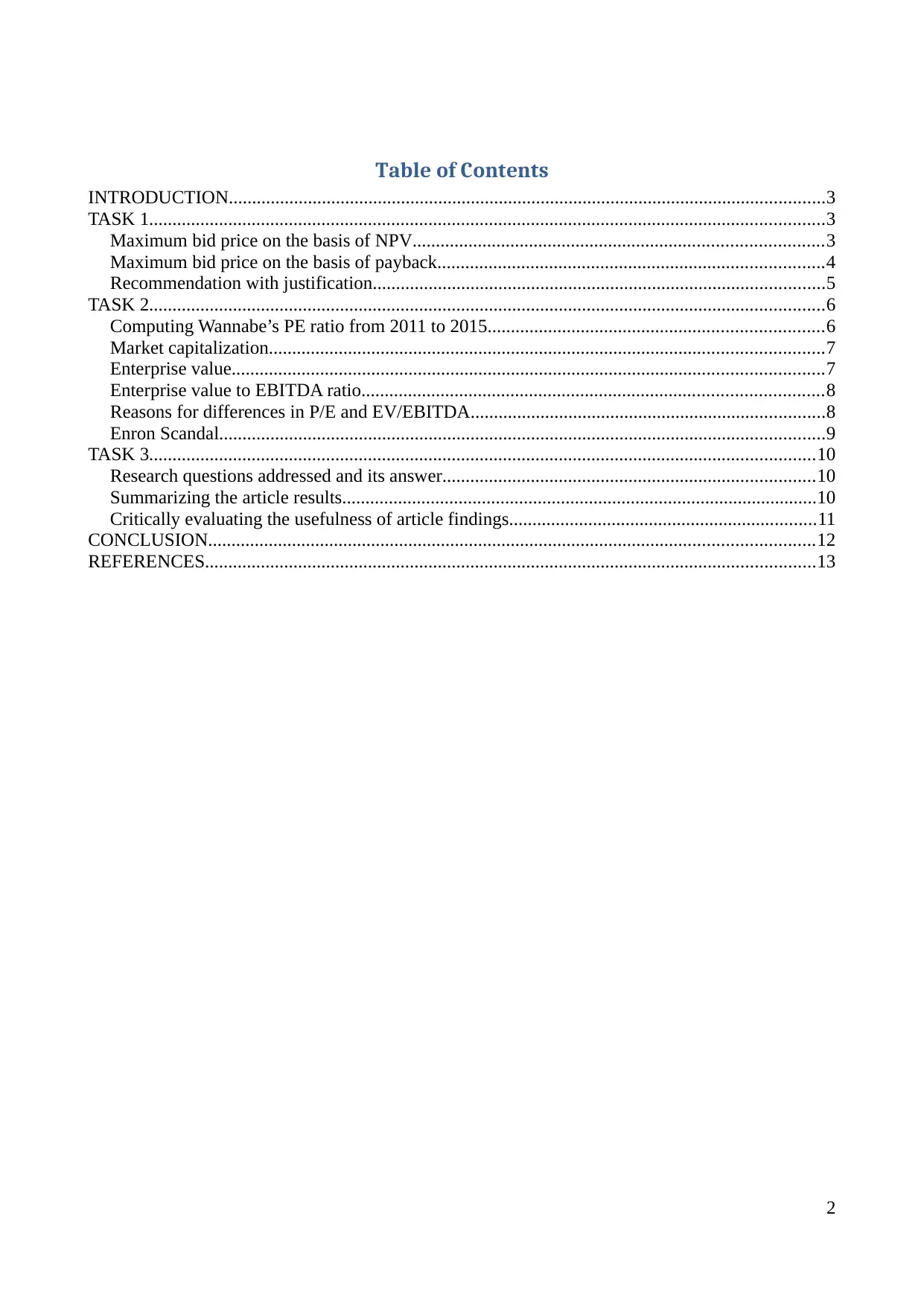
Table of Contents
INTRODUCTION................................................................................................................................3
TASK 1.................................................................................................................................................3
Maximum bid price on the basis of NPV........................................................................................3
Maximum bid price on the basis of payback...................................................................................4
Recommendation with justification.................................................................................................5
TASK 2.................................................................................................................................................6
Computing Wannabe’s PE ratio from 2011 to 2015........................................................................6
Market capitalization.......................................................................................................................7
Enterprise value...............................................................................................................................7
Enterprise value to EBITDA ratio...................................................................................................8
Reasons for differences in P/E and EV/EBITDA............................................................................8
Enron Scandal..................................................................................................................................9
TASK 3...............................................................................................................................................10
Research questions addressed and its answer................................................................................10
Summarizing the article results......................................................................................................10
Critically evaluating the usefulness of article findings..................................................................11
CONCLUSION..................................................................................................................................12
REFERENCES...................................................................................................................................13
2
INTRODUCTION................................................................................................................................3
TASK 1.................................................................................................................................................3
Maximum bid price on the basis of NPV........................................................................................3
Maximum bid price on the basis of payback...................................................................................4
Recommendation with justification.................................................................................................5
TASK 2.................................................................................................................................................6
Computing Wannabe’s PE ratio from 2011 to 2015........................................................................6
Market capitalization.......................................................................................................................7
Enterprise value...............................................................................................................................7
Enterprise value to EBITDA ratio...................................................................................................8
Reasons for differences in P/E and EV/EBITDA............................................................................8
Enron Scandal..................................................................................................................................9
TASK 3...............................................................................................................................................10
Research questions addressed and its answer................................................................................10
Summarizing the article results......................................................................................................10
Critically evaluating the usefulness of article findings..................................................................11
CONCLUSION..................................................................................................................................12
REFERENCES...................................................................................................................................13
2
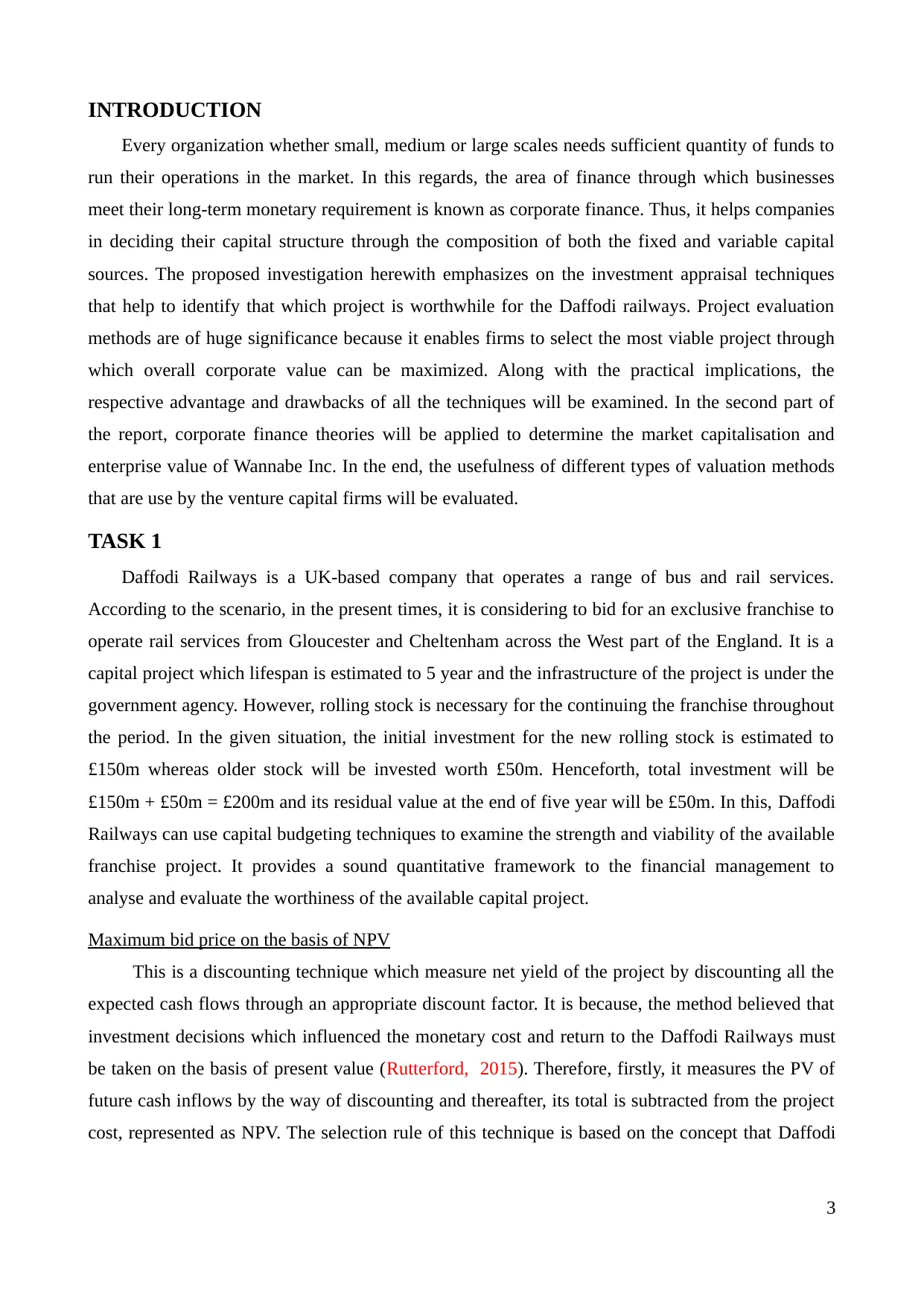
INTRODUCTION
Every organization whether small, medium or large scales needs sufficient quantity of funds to
run their operations in the market. In this regards, the area of finance through which businesses
meet their long-term monetary requirement is known as corporate finance. Thus, it helps companies
in deciding their capital structure through the composition of both the fixed and variable capital
sources. The proposed investigation herewith emphasizes on the investment appraisal techniques
that help to identify that which project is worthwhile for the Daffodi railways. Project evaluation
methods are of huge significance because it enables firms to select the most viable project through
which overall corporate value can be maximized. Along with the practical implications, the
respective advantage and drawbacks of all the techniques will be examined. In the second part of
the report, corporate finance theories will be applied to determine the market capitalisation and
enterprise value of Wannabe Inc. In the end, the usefulness of different types of valuation methods
that are use by the venture capital firms will be evaluated.
TASK 1
Daffodi Railways is a UK-based company that operates a range of bus and rail services.
According to the scenario, in the present times, it is considering to bid for an exclusive franchise to
operate rail services from Gloucester and Cheltenham across the West part of the England. It is a
capital project which lifespan is estimated to 5 year and the infrastructure of the project is under the
government agency. However, rolling stock is necessary for the continuing the franchise throughout
the period. In the given situation, the initial investment for the new rolling stock is estimated to
£150m whereas older stock will be invested worth £50m. Henceforth, total investment will be
£150m + £50m = £200m and its residual value at the end of five year will be £50m. In this, Daffodi
Railways can use capital budgeting techniques to examine the strength and viability of the available
franchise project. It provides a sound quantitative framework to the financial management to
analyse and evaluate the worthiness of the available capital project.
Maximum bid price on the basis of NPV
This is a discounting technique which measure net yield of the project by discounting all the
expected cash flows through an appropriate discount factor. It is because, the method believed that
investment decisions which influenced the monetary cost and return to the Daffodi Railways must
be taken on the basis of present value (Rutterford, 2015). Therefore, firstly, it measures the PV of
future cash inflows by the way of discounting and thereafter, its total is subtracted from the project
cost, represented as NPV. The selection rule of this technique is based on the concept that Daffodi
3
Every organization whether small, medium or large scales needs sufficient quantity of funds to
run their operations in the market. In this regards, the area of finance through which businesses
meet their long-term monetary requirement is known as corporate finance. Thus, it helps companies
in deciding their capital structure through the composition of both the fixed and variable capital
sources. The proposed investigation herewith emphasizes on the investment appraisal techniques
that help to identify that which project is worthwhile for the Daffodi railways. Project evaluation
methods are of huge significance because it enables firms to select the most viable project through
which overall corporate value can be maximized. Along with the practical implications, the
respective advantage and drawbacks of all the techniques will be examined. In the second part of
the report, corporate finance theories will be applied to determine the market capitalisation and
enterprise value of Wannabe Inc. In the end, the usefulness of different types of valuation methods
that are use by the venture capital firms will be evaluated.
TASK 1
Daffodi Railways is a UK-based company that operates a range of bus and rail services.
According to the scenario, in the present times, it is considering to bid for an exclusive franchise to
operate rail services from Gloucester and Cheltenham across the West part of the England. It is a
capital project which lifespan is estimated to 5 year and the infrastructure of the project is under the
government agency. However, rolling stock is necessary for the continuing the franchise throughout
the period. In the given situation, the initial investment for the new rolling stock is estimated to
£150m whereas older stock will be invested worth £50m. Henceforth, total investment will be
£150m + £50m = £200m and its residual value at the end of five year will be £50m. In this, Daffodi
Railways can use capital budgeting techniques to examine the strength and viability of the available
franchise project. It provides a sound quantitative framework to the financial management to
analyse and evaluate the worthiness of the available capital project.
Maximum bid price on the basis of NPV
This is a discounting technique which measure net yield of the project by discounting all the
expected cash flows through an appropriate discount factor. It is because, the method believed that
investment decisions which influenced the monetary cost and return to the Daffodi Railways must
be taken on the basis of present value (Rutterford, 2015). Therefore, firstly, it measures the PV of
future cash inflows by the way of discounting and thereafter, its total is subtracted from the project
cost, represented as NPV. The selection rule of this technique is based on the concept that Daffodi
3
⊘ This is a preview!⊘
Do you want full access?
Subscribe today to unlock all pages.

Trusted by 1+ million students worldwide
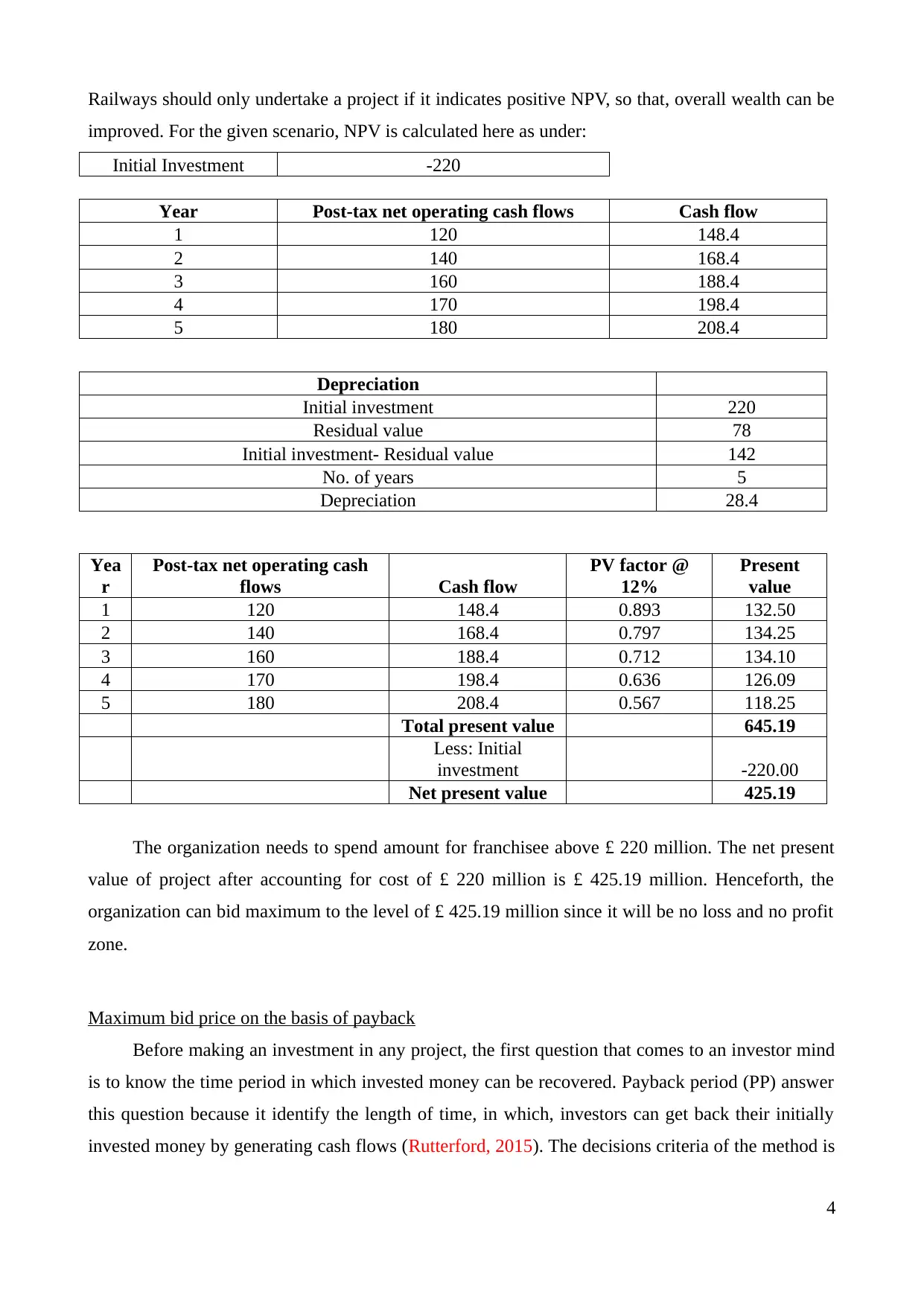
Railways should only undertake a project if it indicates positive NPV, so that, overall wealth can be
improved. For the given scenario, NPV is calculated here as under:
Initial Investment -220
Year Post-tax net operating cash flows Cash flow
1 120 148.4
2 140 168.4
3 160 188.4
4 170 198.4
5 180 208.4
Depreciation
Initial investment 220
Residual value 78
Initial investment- Residual value 142
No. of years 5
Depreciation 28.4
Yea
r
Post-tax net operating cash
flows Cash flow
PV factor @
12%
Present
value
1 120 148.4 0.893 132.50
2 140 168.4 0.797 134.25
3 160 188.4 0.712 134.10
4 170 198.4 0.636 126.09
5 180 208.4 0.567 118.25
Total present value 645.19
Less: Initial
investment -220.00
Net present value 425.19
The organization needs to spend amount for franchisee above £ 220 million. The net present
value of project after accounting for cost of £ 220 million is £ 425.19 million. Henceforth, the
organization can bid maximum to the level of £ 425.19 million since it will be no loss and no profit
zone.
Maximum bid price on the basis of payback
Before making an investment in any project, the first question that comes to an investor mind
is to know the time period in which invested money can be recovered. Payback period (PP) answer
this question because it identify the length of time, in which, investors can get back their initially
invested money by generating cash flows (Rutterford, 2015). The decisions criteria of the method is
4
improved. For the given scenario, NPV is calculated here as under:
Initial Investment -220
Year Post-tax net operating cash flows Cash flow
1 120 148.4
2 140 168.4
3 160 188.4
4 170 198.4
5 180 208.4
Depreciation
Initial investment 220
Residual value 78
Initial investment- Residual value 142
No. of years 5
Depreciation 28.4
Yea
r
Post-tax net operating cash
flows Cash flow
PV factor @
12%
Present
value
1 120 148.4 0.893 132.50
2 140 168.4 0.797 134.25
3 160 188.4 0.712 134.10
4 170 198.4 0.636 126.09
5 180 208.4 0.567 118.25
Total present value 645.19
Less: Initial
investment -220.00
Net present value 425.19
The organization needs to spend amount for franchisee above £ 220 million. The net present
value of project after accounting for cost of £ 220 million is £ 425.19 million. Henceforth, the
organization can bid maximum to the level of £ 425.19 million since it will be no loss and no profit
zone.
Maximum bid price on the basis of payback
Before making an investment in any project, the first question that comes to an investor mind
is to know the time period in which invested money can be recovered. Payback period (PP) answer
this question because it identify the length of time, in which, investors can get back their initially
invested money by generating cash flows (Rutterford, 2015). The decisions criteria of the method is
4
Paraphrase This Document
Need a fresh take? Get an instant paraphrase of this document with our AI Paraphraser
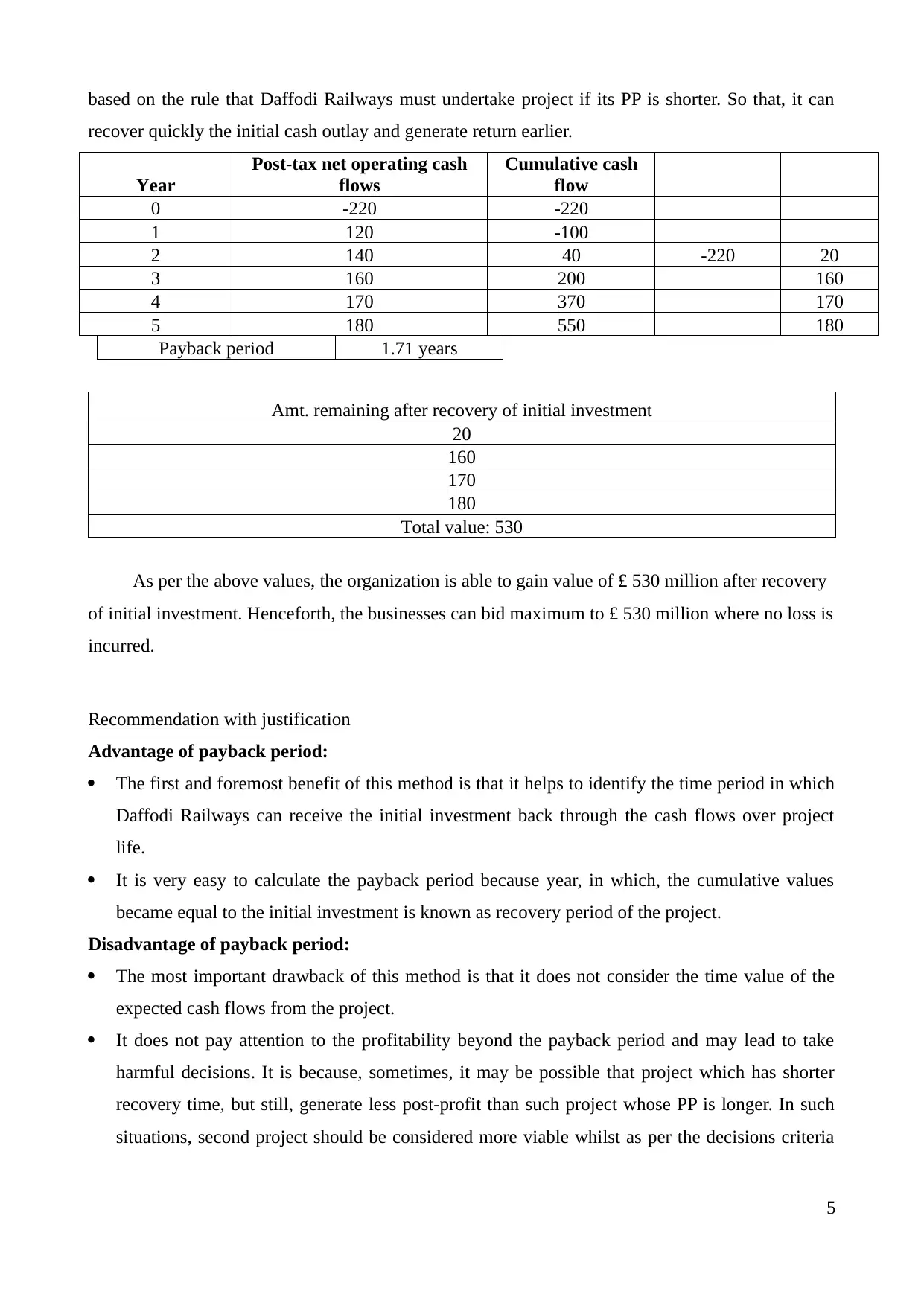
based on the rule that Daffodi Railways must undertake project if its PP is shorter. So that, it can
recover quickly the initial cash outlay and generate return earlier.
Year
Post-tax net operating cash
flows
Cumulative cash
flow
0 -220 -220
1 120 -100
2 140 40 -220 20
3 160 200 160
4 170 370 170
5 180 550 180
Payback period 1.71 years
Amt. remaining after recovery of initial investment
20
160
170
180
Total value: 530
As per the above values, the organization is able to gain value of £ 530 million after recovery
of initial investment. Henceforth, the businesses can bid maximum to £ 530 million where no loss is
incurred.
Recommendation with justification
Advantage of payback period:
The first and foremost benefit of this method is that it helps to identify the time period in which
Daffodi Railways can receive the initial investment back through the cash flows over project
life.
It is very easy to calculate the payback period because year, in which, the cumulative values
became equal to the initial investment is known as recovery period of the project.
Disadvantage of payback period:
The most important drawback of this method is that it does not consider the time value of the
expected cash flows from the project.
It does not pay attention to the profitability beyond the payback period and may lead to take
harmful decisions. It is because, sometimes, it may be possible that project which has shorter
recovery time, but still, generate less post-profit than such project whose PP is longer. In such
situations, second project should be considered more viable whilst as per the decisions criteria
5
recover quickly the initial cash outlay and generate return earlier.
Year
Post-tax net operating cash
flows
Cumulative cash
flow
0 -220 -220
1 120 -100
2 140 40 -220 20
3 160 200 160
4 170 370 170
5 180 550 180
Payback period 1.71 years
Amt. remaining after recovery of initial investment
20
160
170
180
Total value: 530
As per the above values, the organization is able to gain value of £ 530 million after recovery
of initial investment. Henceforth, the businesses can bid maximum to £ 530 million where no loss is
incurred.
Recommendation with justification
Advantage of payback period:
The first and foremost benefit of this method is that it helps to identify the time period in which
Daffodi Railways can receive the initial investment back through the cash flows over project
life.
It is very easy to calculate the payback period because year, in which, the cumulative values
became equal to the initial investment is known as recovery period of the project.
Disadvantage of payback period:
The most important drawback of this method is that it does not consider the time value of the
expected cash flows from the project.
It does not pay attention to the profitability beyond the payback period and may lead to take
harmful decisions. It is because, sometimes, it may be possible that project which has shorter
recovery time, but still, generate less post-profit than such project whose PP is longer. In such
situations, second project should be considered more viable whilst as per the decisions criteria
5
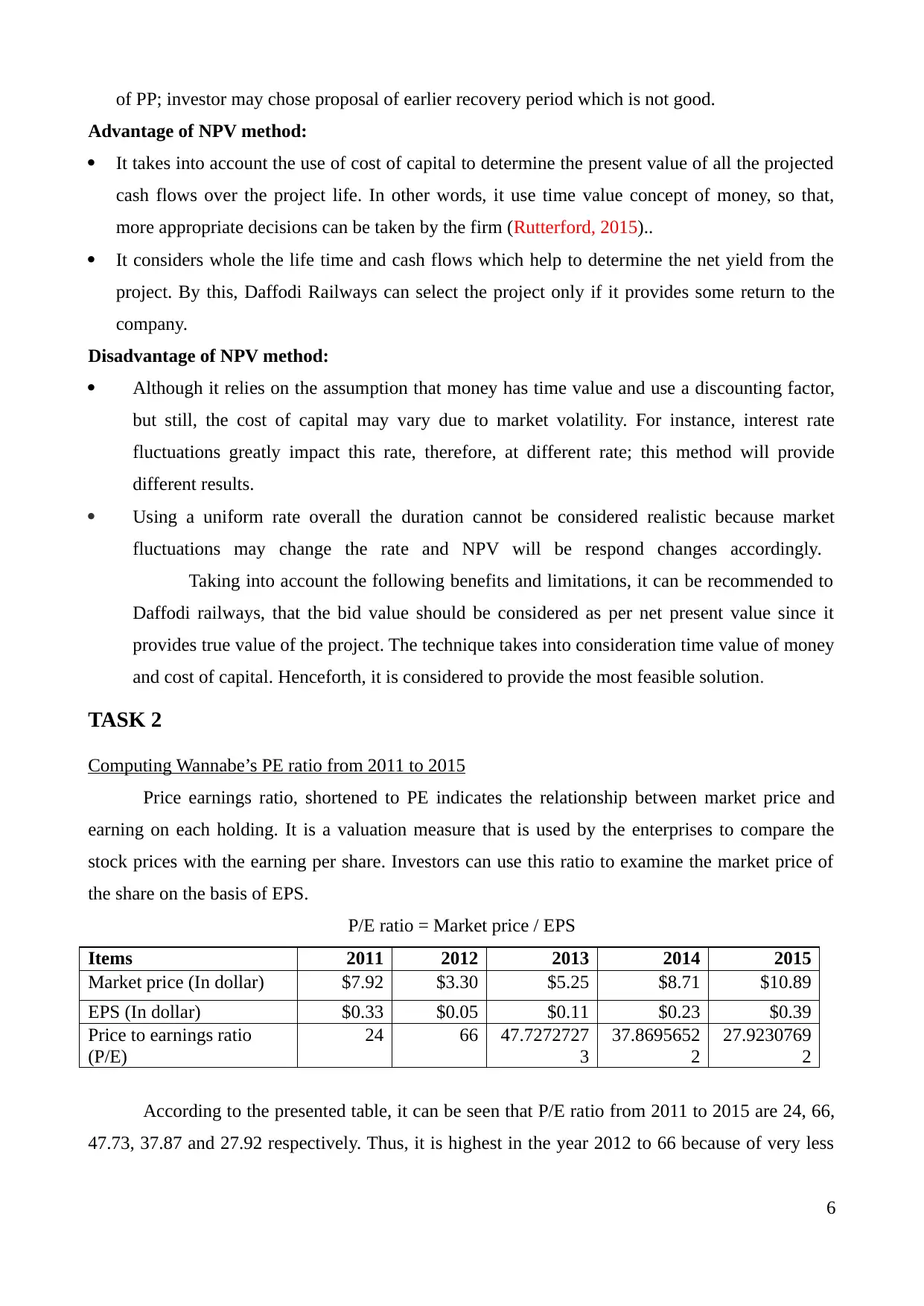
of PP; investor may chose proposal of earlier recovery period which is not good.
Advantage of NPV method:
It takes into account the use of cost of capital to determine the present value of all the projected
cash flows over the project life. In other words, it use time value concept of money, so that,
more appropriate decisions can be taken by the firm (Rutterford, 2015)..
It considers whole the life time and cash flows which help to determine the net yield from the
project. By this, Daffodi Railways can select the project only if it provides some return to the
company.
Disadvantage of NPV method:
Although it relies on the assumption that money has time value and use a discounting factor,
but still, the cost of capital may vary due to market volatility. For instance, interest rate
fluctuations greatly impact this rate, therefore, at different rate; this method will provide
different results.
Using a uniform rate overall the duration cannot be considered realistic because market
fluctuations may change the rate and NPV will be respond changes accordingly.
Taking into account the following benefits and limitations, it can be recommended to
Daffodi railways, that the bid value should be considered as per net present value since it
provides true value of the project. The technique takes into consideration time value of money
and cost of capital. Henceforth, it is considered to provide the most feasible solution.
TASK 2
Computing Wannabe’s PE ratio from 2011 to 2015
Price earnings ratio, shortened to PE indicates the relationship between market price and
earning on each holding. It is a valuation measure that is used by the enterprises to compare the
stock prices with the earning per share. Investors can use this ratio to examine the market price of
the share on the basis of EPS.
P/E ratio = Market price / EPS
Items 2011 2012 2013 2014 2015
Market price (In dollar) $7.92 $3.30 $5.25 $8.71 $10.89
EPS (In dollar) $0.33 $0.05 $0.11 $0.23 $0.39
Price to earnings ratio
(P/E)
24 66 47.7272727
3
37.8695652
2
27.9230769
2
According to the presented table, it can be seen that P/E ratio from 2011 to 2015 are 24, 66,
47.73, 37.87 and 27.92 respectively. Thus, it is highest in the year 2012 to 66 because of very less
6
Advantage of NPV method:
It takes into account the use of cost of capital to determine the present value of all the projected
cash flows over the project life. In other words, it use time value concept of money, so that,
more appropriate decisions can be taken by the firm (Rutterford, 2015)..
It considers whole the life time and cash flows which help to determine the net yield from the
project. By this, Daffodi Railways can select the project only if it provides some return to the
company.
Disadvantage of NPV method:
Although it relies on the assumption that money has time value and use a discounting factor,
but still, the cost of capital may vary due to market volatility. For instance, interest rate
fluctuations greatly impact this rate, therefore, at different rate; this method will provide
different results.
Using a uniform rate overall the duration cannot be considered realistic because market
fluctuations may change the rate and NPV will be respond changes accordingly.
Taking into account the following benefits and limitations, it can be recommended to
Daffodi railways, that the bid value should be considered as per net present value since it
provides true value of the project. The technique takes into consideration time value of money
and cost of capital. Henceforth, it is considered to provide the most feasible solution.
TASK 2
Computing Wannabe’s PE ratio from 2011 to 2015
Price earnings ratio, shortened to PE indicates the relationship between market price and
earning on each holding. It is a valuation measure that is used by the enterprises to compare the
stock prices with the earning per share. Investors can use this ratio to examine the market price of
the share on the basis of EPS.
P/E ratio = Market price / EPS
Items 2011 2012 2013 2014 2015
Market price (In dollar) $7.92 $3.30 $5.25 $8.71 $10.89
EPS (In dollar) $0.33 $0.05 $0.11 $0.23 $0.39
Price to earnings ratio
(P/E)
24 66 47.7272727
3
37.8695652
2
27.9230769
2
According to the presented table, it can be seen that P/E ratio from 2011 to 2015 are 24, 66,
47.73, 37.87 and 27.92 respectively. Thus, it is highest in the year 2012 to 66 because of very less
6
⊘ This is a preview!⊘
Do you want full access?
Subscribe today to unlock all pages.

Trusted by 1+ million students worldwide
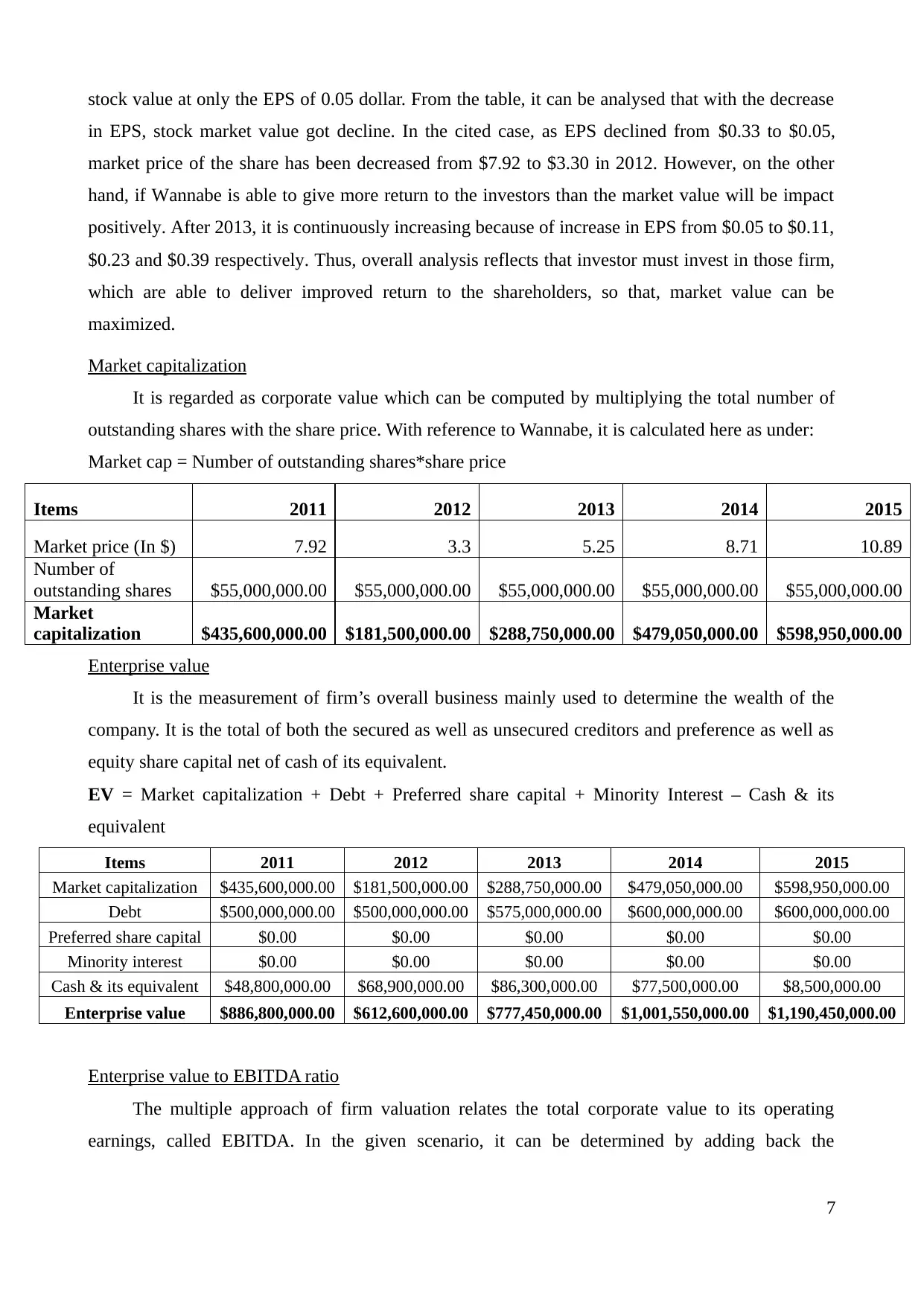
stock value at only the EPS of 0.05 dollar. From the table, it can be analysed that with the decrease
in EPS, stock market value got decline. In the cited case, as EPS declined from $0.33 to $0.05,
market price of the share has been decreased from $7.92 to $3.30 in 2012. However, on the other
hand, if Wannabe is able to give more return to the investors than the market value will be impact
positively. After 2013, it is continuously increasing because of increase in EPS from $0.05 to $0.11,
$0.23 and $0.39 respectively. Thus, overall analysis reflects that investor must invest in those firm,
which are able to deliver improved return to the shareholders, so that, market value can be
maximized.
Market capitalization
It is regarded as corporate value which can be computed by multiplying the total number of
outstanding shares with the share price. With reference to Wannabe, it is calculated here as under:
Market cap = Number of outstanding shares*share price
Items 2011 2012 2013 2014 2015
Market price (In $) 7.92 3.3 5.25 8.71 10.89
Number of
outstanding shares $55,000,000.00 $55,000,000.00 $55,000,000.00 $55,000,000.00 $55,000,000.00
Market
capitalization $435,600,000.00 $181,500,000.00 $288,750,000.00 $479,050,000.00 $598,950,000.00
Enterprise value
It is the measurement of firm’s overall business mainly used to determine the wealth of the
company. It is the total of both the secured as well as unsecured creditors and preference as well as
equity share capital net of cash of its equivalent.
EV = Market capitalization + Debt + Preferred share capital + Minority Interest – Cash & its
equivalent
Items 2011 2012 2013 2014 2015
Market capitalization $435,600,000.00 $181,500,000.00 $288,750,000.00 $479,050,000.00 $598,950,000.00
Debt $500,000,000.00 $500,000,000.00 $575,000,000.00 $600,000,000.00 $600,000,000.00
Preferred share capital $0.00 $0.00 $0.00 $0.00 $0.00
Minority interest $0.00 $0.00 $0.00 $0.00 $0.00
Cash & its equivalent $48,800,000.00 $68,900,000.00 $86,300,000.00 $77,500,000.00 $8,500,000.00
Enterprise value $886,800,000.00 $612,600,000.00 $777,450,000.00 $1,001,550,000.00 $1,190,450,000.00
Enterprise value to EBITDA ratio
The multiple approach of firm valuation relates the total corporate value to its operating
earnings, called EBITDA. In the given scenario, it can be determined by adding back the
7
in EPS, stock market value got decline. In the cited case, as EPS declined from $0.33 to $0.05,
market price of the share has been decreased from $7.92 to $3.30 in 2012. However, on the other
hand, if Wannabe is able to give more return to the investors than the market value will be impact
positively. After 2013, it is continuously increasing because of increase in EPS from $0.05 to $0.11,
$0.23 and $0.39 respectively. Thus, overall analysis reflects that investor must invest in those firm,
which are able to deliver improved return to the shareholders, so that, market value can be
maximized.
Market capitalization
It is regarded as corporate value which can be computed by multiplying the total number of
outstanding shares with the share price. With reference to Wannabe, it is calculated here as under:
Market cap = Number of outstanding shares*share price
Items 2011 2012 2013 2014 2015
Market price (In $) 7.92 3.3 5.25 8.71 10.89
Number of
outstanding shares $55,000,000.00 $55,000,000.00 $55,000,000.00 $55,000,000.00 $55,000,000.00
Market
capitalization $435,600,000.00 $181,500,000.00 $288,750,000.00 $479,050,000.00 $598,950,000.00
Enterprise value
It is the measurement of firm’s overall business mainly used to determine the wealth of the
company. It is the total of both the secured as well as unsecured creditors and preference as well as
equity share capital net of cash of its equivalent.
EV = Market capitalization + Debt + Preferred share capital + Minority Interest – Cash & its
equivalent
Items 2011 2012 2013 2014 2015
Market capitalization $435,600,000.00 $181,500,000.00 $288,750,000.00 $479,050,000.00 $598,950,000.00
Debt $500,000,000.00 $500,000,000.00 $575,000,000.00 $600,000,000.00 $600,000,000.00
Preferred share capital $0.00 $0.00 $0.00 $0.00 $0.00
Minority interest $0.00 $0.00 $0.00 $0.00 $0.00
Cash & its equivalent $48,800,000.00 $68,900,000.00 $86,300,000.00 $77,500,000.00 $8,500,000.00
Enterprise value $886,800,000.00 $612,600,000.00 $777,450,000.00 $1,001,550,000.00 $1,190,450,000.00
Enterprise value to EBITDA ratio
The multiple approach of firm valuation relates the total corporate value to its operating
earnings, called EBITDA. In the given scenario, it can be determined by adding back the
7
Paraphrase This Document
Need a fresh take? Get an instant paraphrase of this document with our AI Paraphraser
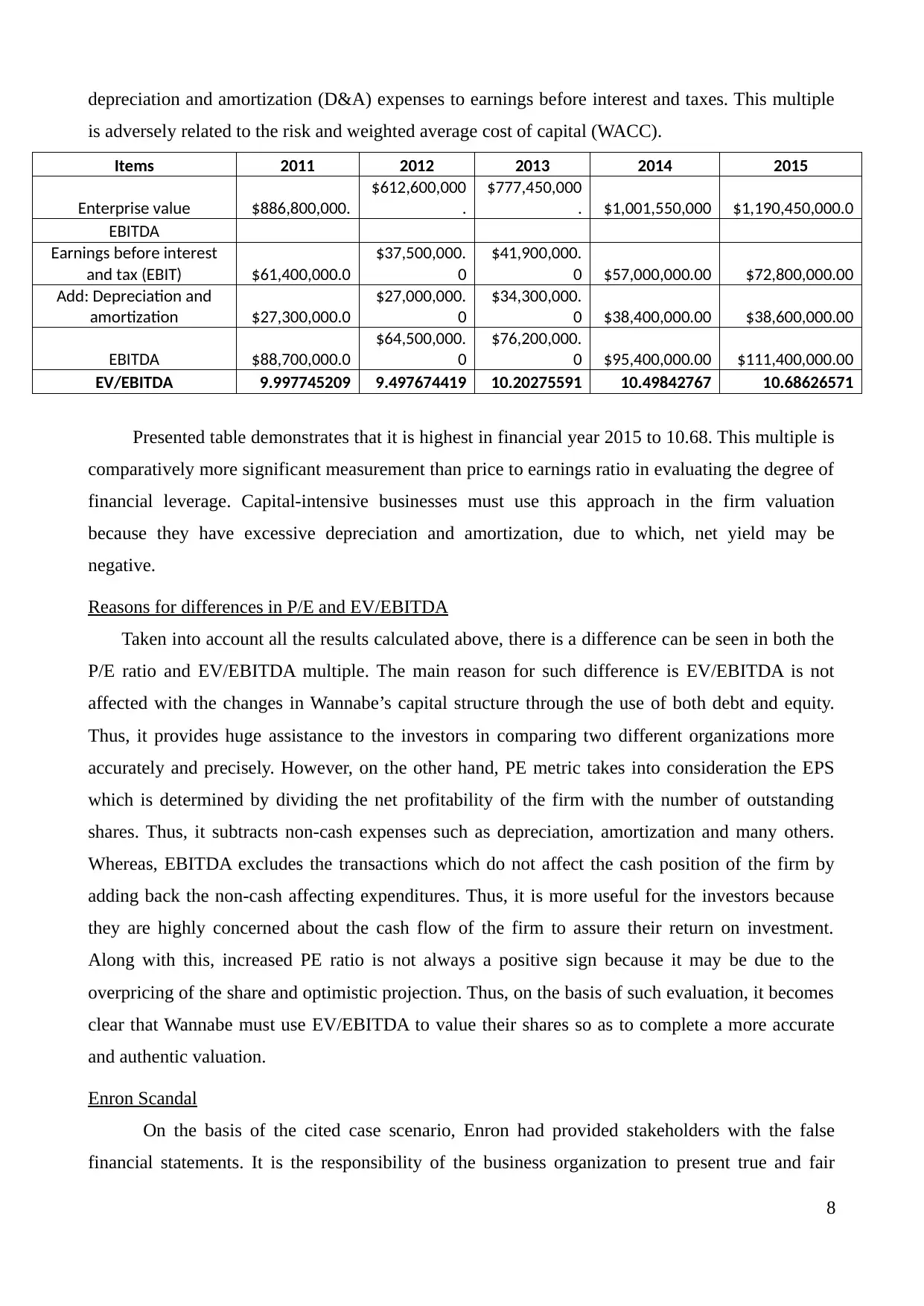
depreciation and amortization (D&A) expenses to earnings before interest and taxes. This multiple
is adversely related to the risk and weighted average cost of capital (WACC).
Items 2011 2012 2013 2014 2015
Enterprise value $886,800,000.
$612,600,000
.
$777,450,000
. $1,001,550,000 $1,190,450,000.0
EBITDA
Earnings before interest
and tax (EBIT) $61,400,000.0
$37,500,000.
0
$41,900,000.
0 $57,000,000.00 $72,800,000.00
Add: Depreciation and
amortization $27,300,000.0
$27,000,000.
0
$34,300,000.
0 $38,400,000.00 $38,600,000.00
EBITDA $88,700,000.0
$64,500,000.
0
$76,200,000.
0 $95,400,000.00 $111,400,000.00
EV/EBITDA 9.997745209 9.497674419 10.20275591 10.49842767 10.68626571
Presented table demonstrates that it is highest in financial year 2015 to 10.68. This multiple is
comparatively more significant measurement than price to earnings ratio in evaluating the degree of
financial leverage. Capital-intensive businesses must use this approach in the firm valuation
because they have excessive depreciation and amortization, due to which, net yield may be
negative.
Reasons for differences in P/E and EV/EBITDA
Taken into account all the results calculated above, there is a difference can be seen in both the
P/E ratio and EV/EBITDA multiple. The main reason for such difference is EV/EBITDA is not
affected with the changes in Wannabe’s capital structure through the use of both debt and equity.
Thus, it provides huge assistance to the investors in comparing two different organizations more
accurately and precisely. However, on the other hand, PE metric takes into consideration the EPS
which is determined by dividing the net profitability of the firm with the number of outstanding
shares. Thus, it subtracts non-cash expenses such as depreciation, amortization and many others.
Whereas, EBITDA excludes the transactions which do not affect the cash position of the firm by
adding back the non-cash affecting expenditures. Thus, it is more useful for the investors because
they are highly concerned about the cash flow of the firm to assure their return on investment.
Along with this, increased PE ratio is not always a positive sign because it may be due to the
overpricing of the share and optimistic projection. Thus, on the basis of such evaluation, it becomes
clear that Wannabe must use EV/EBITDA to value their shares so as to complete a more accurate
and authentic valuation.
Enron Scandal
On the basis of the cited case scenario, Enron had provided stakeholders with the false
financial statements. It is the responsibility of the business organization to present true and fair
8
is adversely related to the risk and weighted average cost of capital (WACC).
Items 2011 2012 2013 2014 2015
Enterprise value $886,800,000.
$612,600,000
.
$777,450,000
. $1,001,550,000 $1,190,450,000.0
EBITDA
Earnings before interest
and tax (EBIT) $61,400,000.0
$37,500,000.
0
$41,900,000.
0 $57,000,000.00 $72,800,000.00
Add: Depreciation and
amortization $27,300,000.0
$27,000,000.
0
$34,300,000.
0 $38,400,000.00 $38,600,000.00
EBITDA $88,700,000.0
$64,500,000.
0
$76,200,000.
0 $95,400,000.00 $111,400,000.00
EV/EBITDA 9.997745209 9.497674419 10.20275591 10.49842767 10.68626571
Presented table demonstrates that it is highest in financial year 2015 to 10.68. This multiple is
comparatively more significant measurement than price to earnings ratio in evaluating the degree of
financial leverage. Capital-intensive businesses must use this approach in the firm valuation
because they have excessive depreciation and amortization, due to which, net yield may be
negative.
Reasons for differences in P/E and EV/EBITDA
Taken into account all the results calculated above, there is a difference can be seen in both the
P/E ratio and EV/EBITDA multiple. The main reason for such difference is EV/EBITDA is not
affected with the changes in Wannabe’s capital structure through the use of both debt and equity.
Thus, it provides huge assistance to the investors in comparing two different organizations more
accurately and precisely. However, on the other hand, PE metric takes into consideration the EPS
which is determined by dividing the net profitability of the firm with the number of outstanding
shares. Thus, it subtracts non-cash expenses such as depreciation, amortization and many others.
Whereas, EBITDA excludes the transactions which do not affect the cash position of the firm by
adding back the non-cash affecting expenditures. Thus, it is more useful for the investors because
they are highly concerned about the cash flow of the firm to assure their return on investment.
Along with this, increased PE ratio is not always a positive sign because it may be due to the
overpricing of the share and optimistic projection. Thus, on the basis of such evaluation, it becomes
clear that Wannabe must use EV/EBITDA to value their shares so as to complete a more accurate
and authentic valuation.
Enron Scandal
On the basis of the cited case scenario, Enron had provided stakeholders with the false
financial statements. It is the responsibility of the business organization to present true and fair
8
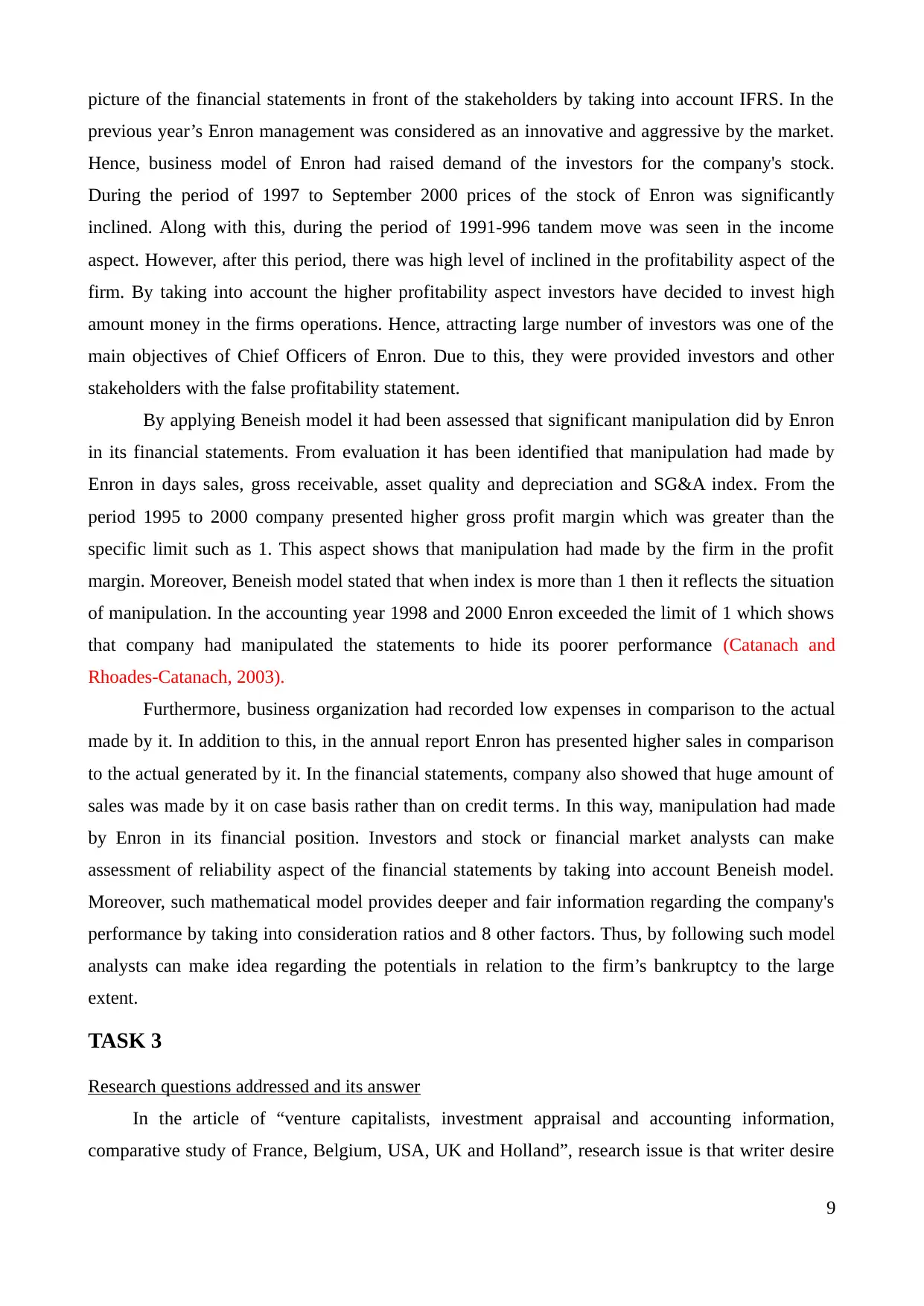
picture of the financial statements in front of the stakeholders by taking into account IFRS. In the
previous year’s Enron management was considered as an innovative and aggressive by the market.
Hence, business model of Enron had raised demand of the investors for the company's stock.
During the period of 1997 to September 2000 prices of the stock of Enron was significantly
inclined. Along with this, during the period of 1991-996 tandem move was seen in the income
aspect. However, after this period, there was high level of inclined in the profitability aspect of the
firm. By taking into account the higher profitability aspect investors have decided to invest high
amount money in the firms operations. Hence, attracting large number of investors was one of the
main objectives of Chief Officers of Enron. Due to this, they were provided investors and other
stakeholders with the false profitability statement.
By applying Beneish model it had been assessed that significant manipulation did by Enron
in its financial statements. From evaluation it has been identified that manipulation had made by
Enron in days sales, gross receivable, asset quality and depreciation and SG&A index. From the
period 1995 to 2000 company presented higher gross profit margin which was greater than the
specific limit such as 1. This aspect shows that manipulation had made by the firm in the profit
margin. Moreover, Beneish model stated that when index is more than 1 then it reflects the situation
of manipulation. In the accounting year 1998 and 2000 Enron exceeded the limit of 1 which shows
that company had manipulated the statements to hide its poorer performance (Catanach and
Rhoades-Catanach, 2003).
Furthermore, business organization had recorded low expenses in comparison to the actual
made by it. In addition to this, in the annual report Enron has presented higher sales in comparison
to the actual generated by it. In the financial statements, company also showed that huge amount of
sales was made by it on case basis rather than on credit terms. In this way, manipulation had made
by Enron in its financial position. Investors and stock or financial market analysts can make
assessment of reliability aspect of the financial statements by taking into account Beneish model.
Moreover, such mathematical model provides deeper and fair information regarding the company's
performance by taking into consideration ratios and 8 other factors. Thus, by following such model
analysts can make idea regarding the potentials in relation to the firm’s bankruptcy to the large
extent.
TASK 3
Research questions addressed and its answer
In the article of “venture capitalists, investment appraisal and accounting information,
comparative study of France, Belgium, USA, UK and Holland”, research issue is that writer desire
9
previous year’s Enron management was considered as an innovative and aggressive by the market.
Hence, business model of Enron had raised demand of the investors for the company's stock.
During the period of 1997 to September 2000 prices of the stock of Enron was significantly
inclined. Along with this, during the period of 1991-996 tandem move was seen in the income
aspect. However, after this period, there was high level of inclined in the profitability aspect of the
firm. By taking into account the higher profitability aspect investors have decided to invest high
amount money in the firms operations. Hence, attracting large number of investors was one of the
main objectives of Chief Officers of Enron. Due to this, they were provided investors and other
stakeholders with the false profitability statement.
By applying Beneish model it had been assessed that significant manipulation did by Enron
in its financial statements. From evaluation it has been identified that manipulation had made by
Enron in days sales, gross receivable, asset quality and depreciation and SG&A index. From the
period 1995 to 2000 company presented higher gross profit margin which was greater than the
specific limit such as 1. This aspect shows that manipulation had made by the firm in the profit
margin. Moreover, Beneish model stated that when index is more than 1 then it reflects the situation
of manipulation. In the accounting year 1998 and 2000 Enron exceeded the limit of 1 which shows
that company had manipulated the statements to hide its poorer performance (Catanach and
Rhoades-Catanach, 2003).
Furthermore, business organization had recorded low expenses in comparison to the actual
made by it. In addition to this, in the annual report Enron has presented higher sales in comparison
to the actual generated by it. In the financial statements, company also showed that huge amount of
sales was made by it on case basis rather than on credit terms. In this way, manipulation had made
by Enron in its financial position. Investors and stock or financial market analysts can make
assessment of reliability aspect of the financial statements by taking into account Beneish model.
Moreover, such mathematical model provides deeper and fair information regarding the company's
performance by taking into consideration ratios and 8 other factors. Thus, by following such model
analysts can make idea regarding the potentials in relation to the firm’s bankruptcy to the large
extent.
TASK 3
Research questions addressed and its answer
In the article of “venture capitalists, investment appraisal and accounting information,
comparative study of France, Belgium, USA, UK and Holland”, research issue is that writer desire
9
⊘ This is a preview!⊘
Do you want full access?
Subscribe today to unlock all pages.

Trusted by 1+ million students worldwide
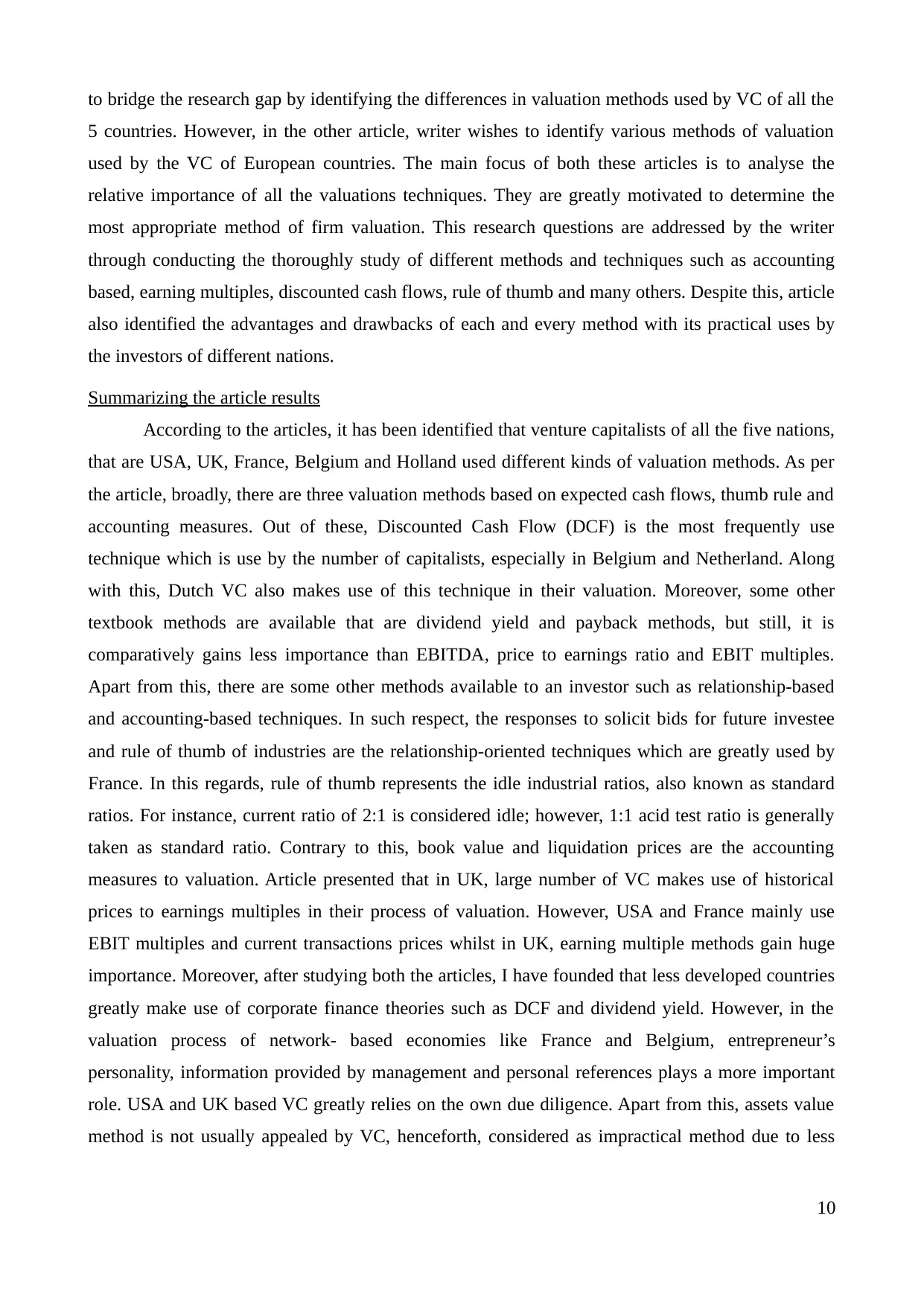
to bridge the research gap by identifying the differences in valuation methods used by VC of all the
5 countries. However, in the other article, writer wishes to identify various methods of valuation
used by the VC of European countries. The main focus of both these articles is to analyse the
relative importance of all the valuations techniques. They are greatly motivated to determine the
most appropriate method of firm valuation. This research questions are addressed by the writer
through conducting the thoroughly study of different methods and techniques such as accounting
based, earning multiples, discounted cash flows, rule of thumb and many others. Despite this, article
also identified the advantages and drawbacks of each and every method with its practical uses by
the investors of different nations.
Summarizing the article results
According to the articles, it has been identified that venture capitalists of all the five nations,
that are USA, UK, France, Belgium and Holland used different kinds of valuation methods. As per
the article, broadly, there are three valuation methods based on expected cash flows, thumb rule and
accounting measures. Out of these, Discounted Cash Flow (DCF) is the most frequently use
technique which is use by the number of capitalists, especially in Belgium and Netherland. Along
with this, Dutch VC also makes use of this technique in their valuation. Moreover, some other
textbook methods are available that are dividend yield and payback methods, but still, it is
comparatively gains less importance than EBITDA, price to earnings ratio and EBIT multiples.
Apart from this, there are some other methods available to an investor such as relationship-based
and accounting-based techniques. In such respect, the responses to solicit bids for future investee
and rule of thumb of industries are the relationship-oriented techniques which are greatly used by
France. In this regards, rule of thumb represents the idle industrial ratios, also known as standard
ratios. For instance, current ratio of 2:1 is considered idle; however, 1:1 acid test ratio is generally
taken as standard ratio. Contrary to this, book value and liquidation prices are the accounting
measures to valuation. Article presented that in UK, large number of VC makes use of historical
prices to earnings multiples in their process of valuation. However, USA and France mainly use
EBIT multiples and current transactions prices whilst in UK, earning multiple methods gain huge
importance. Moreover, after studying both the articles, I have founded that less developed countries
greatly make use of corporate finance theories such as DCF and dividend yield. However, in the
valuation process of network- based economies like France and Belgium, entrepreneur’s
personality, information provided by management and personal references plays a more important
role. USA and UK based VC greatly relies on the own due diligence. Apart from this, assets value
method is not usually appealed by VC, henceforth, considered as impractical method due to less
10
5 countries. However, in the other article, writer wishes to identify various methods of valuation
used by the VC of European countries. The main focus of both these articles is to analyse the
relative importance of all the valuations techniques. They are greatly motivated to determine the
most appropriate method of firm valuation. This research questions are addressed by the writer
through conducting the thoroughly study of different methods and techniques such as accounting
based, earning multiples, discounted cash flows, rule of thumb and many others. Despite this, article
also identified the advantages and drawbacks of each and every method with its practical uses by
the investors of different nations.
Summarizing the article results
According to the articles, it has been identified that venture capitalists of all the five nations,
that are USA, UK, France, Belgium and Holland used different kinds of valuation methods. As per
the article, broadly, there are three valuation methods based on expected cash flows, thumb rule and
accounting measures. Out of these, Discounted Cash Flow (DCF) is the most frequently use
technique which is use by the number of capitalists, especially in Belgium and Netherland. Along
with this, Dutch VC also makes use of this technique in their valuation. Moreover, some other
textbook methods are available that are dividend yield and payback methods, but still, it is
comparatively gains less importance than EBITDA, price to earnings ratio and EBIT multiples.
Apart from this, there are some other methods available to an investor such as relationship-based
and accounting-based techniques. In such respect, the responses to solicit bids for future investee
and rule of thumb of industries are the relationship-oriented techniques which are greatly used by
France. In this regards, rule of thumb represents the idle industrial ratios, also known as standard
ratios. For instance, current ratio of 2:1 is considered idle; however, 1:1 acid test ratio is generally
taken as standard ratio. Contrary to this, book value and liquidation prices are the accounting
measures to valuation. Article presented that in UK, large number of VC makes use of historical
prices to earnings multiples in their process of valuation. However, USA and France mainly use
EBIT multiples and current transactions prices whilst in UK, earning multiple methods gain huge
importance. Moreover, after studying both the articles, I have founded that less developed countries
greatly make use of corporate finance theories such as DCF and dividend yield. However, in the
valuation process of network- based economies like France and Belgium, entrepreneur’s
personality, information provided by management and personal references plays a more important
role. USA and UK based VC greatly relies on the own due diligence. Apart from this, assets value
method is not usually appealed by VC, henceforth, considered as impractical method due to less
10
Paraphrase This Document
Need a fresh take? Get an instant paraphrase of this document with our AI Paraphraser
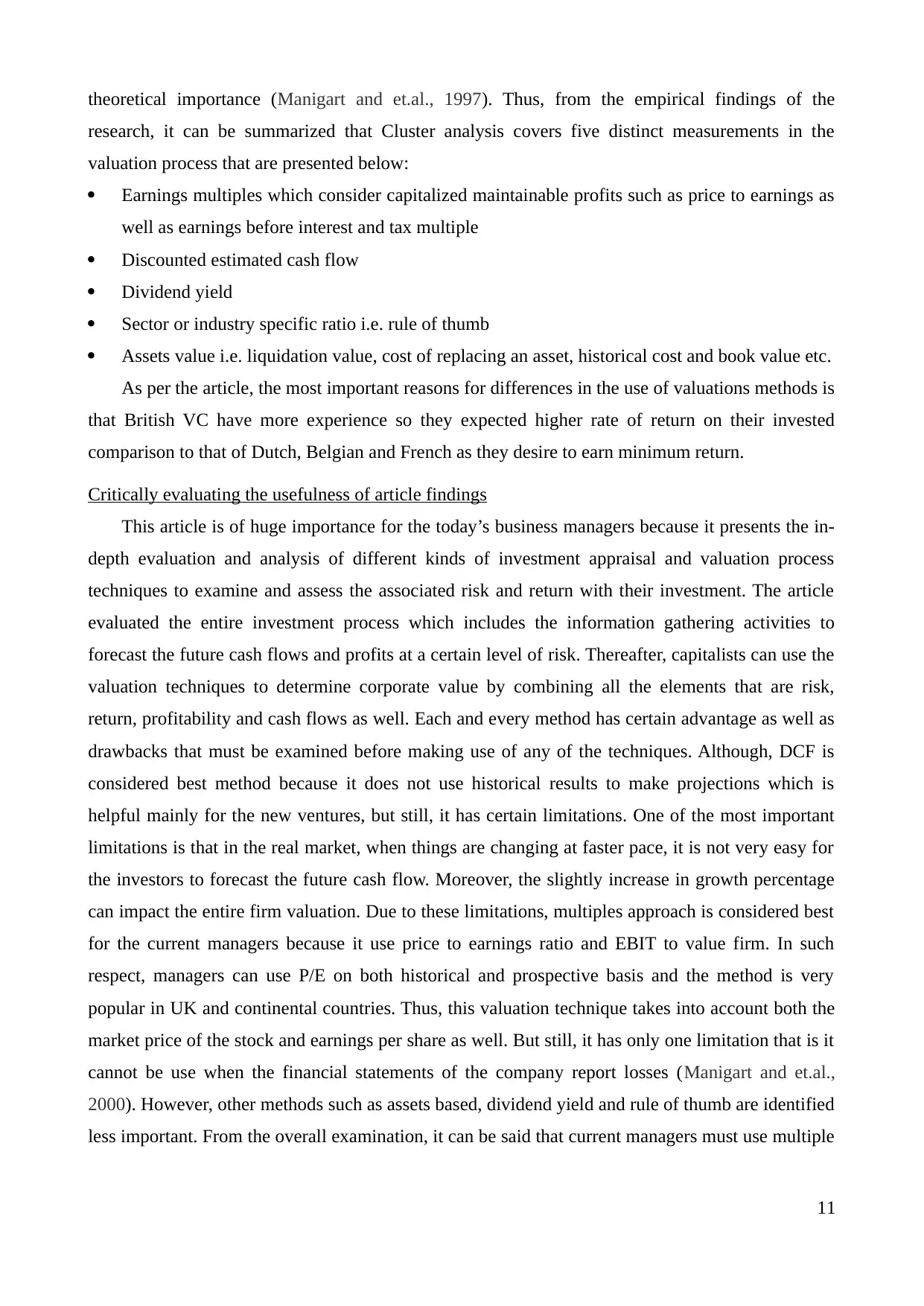
theoretical importance (Manigart and et.al., 1997). Thus, from the empirical findings of the
research, it can be summarized that Cluster analysis covers five distinct measurements in the
valuation process that are presented below:
Earnings multiples which consider capitalized maintainable profits such as price to earnings as
well as earnings before interest and tax multiple
Discounted estimated cash flow
Dividend yield
Sector or industry specific ratio i.e. rule of thumb
Assets value i.e. liquidation value, cost of replacing an asset, historical cost and book value etc.
As per the article, the most important reasons for differences in the use of valuations methods is
that British VC have more experience so they expected higher rate of return on their invested
comparison to that of Dutch, Belgian and French as they desire to earn minimum return.
Critically evaluating the usefulness of article findings
This article is of huge importance for the today’s business managers because it presents the in-
depth evaluation and analysis of different kinds of investment appraisal and valuation process
techniques to examine and assess the associated risk and return with their investment. The article
evaluated the entire investment process which includes the information gathering activities to
forecast the future cash flows and profits at a certain level of risk. Thereafter, capitalists can use the
valuation techniques to determine corporate value by combining all the elements that are risk,
return, profitability and cash flows as well. Each and every method has certain advantage as well as
drawbacks that must be examined before making use of any of the techniques. Although, DCF is
considered best method because it does not use historical results to make projections which is
helpful mainly for the new ventures, but still, it has certain limitations. One of the most important
limitations is that in the real market, when things are changing at faster pace, it is not very easy for
the investors to forecast the future cash flow. Moreover, the slightly increase in growth percentage
can impact the entire firm valuation. Due to these limitations, multiples approach is considered best
for the current managers because it use price to earnings ratio and EBIT to value firm. In such
respect, managers can use P/E on both historical and prospective basis and the method is very
popular in UK and continental countries. Thus, this valuation technique takes into account both the
market price of the stock and earnings per share as well. But still, it has only one limitation that is it
cannot be use when the financial statements of the company report losses (Manigart and et.al.,
2000). However, other methods such as assets based, dividend yield and rule of thumb are identified
less important. From the overall examination, it can be said that current managers must use multiple
11
research, it can be summarized that Cluster analysis covers five distinct measurements in the
valuation process that are presented below:
Earnings multiples which consider capitalized maintainable profits such as price to earnings as
well as earnings before interest and tax multiple
Discounted estimated cash flow
Dividend yield
Sector or industry specific ratio i.e. rule of thumb
Assets value i.e. liquidation value, cost of replacing an asset, historical cost and book value etc.
As per the article, the most important reasons for differences in the use of valuations methods is
that British VC have more experience so they expected higher rate of return on their invested
comparison to that of Dutch, Belgian and French as they desire to earn minimum return.
Critically evaluating the usefulness of article findings
This article is of huge importance for the today’s business managers because it presents the in-
depth evaluation and analysis of different kinds of investment appraisal and valuation process
techniques to examine and assess the associated risk and return with their investment. The article
evaluated the entire investment process which includes the information gathering activities to
forecast the future cash flows and profits at a certain level of risk. Thereafter, capitalists can use the
valuation techniques to determine corporate value by combining all the elements that are risk,
return, profitability and cash flows as well. Each and every method has certain advantage as well as
drawbacks that must be examined before making use of any of the techniques. Although, DCF is
considered best method because it does not use historical results to make projections which is
helpful mainly for the new ventures, but still, it has certain limitations. One of the most important
limitations is that in the real market, when things are changing at faster pace, it is not very easy for
the investors to forecast the future cash flow. Moreover, the slightly increase in growth percentage
can impact the entire firm valuation. Due to these limitations, multiples approach is considered best
for the current managers because it use price to earnings ratio and EBIT to value firm. In such
respect, managers can use P/E on both historical and prospective basis and the method is very
popular in UK and continental countries. Thus, this valuation technique takes into account both the
market price of the stock and earnings per share as well. But still, it has only one limitation that is it
cannot be use when the financial statements of the company report losses (Manigart and et.al.,
2000). However, other methods such as assets based, dividend yield and rule of thumb are identified
less important. From the overall examination, it can be said that current managers must use multiple
11
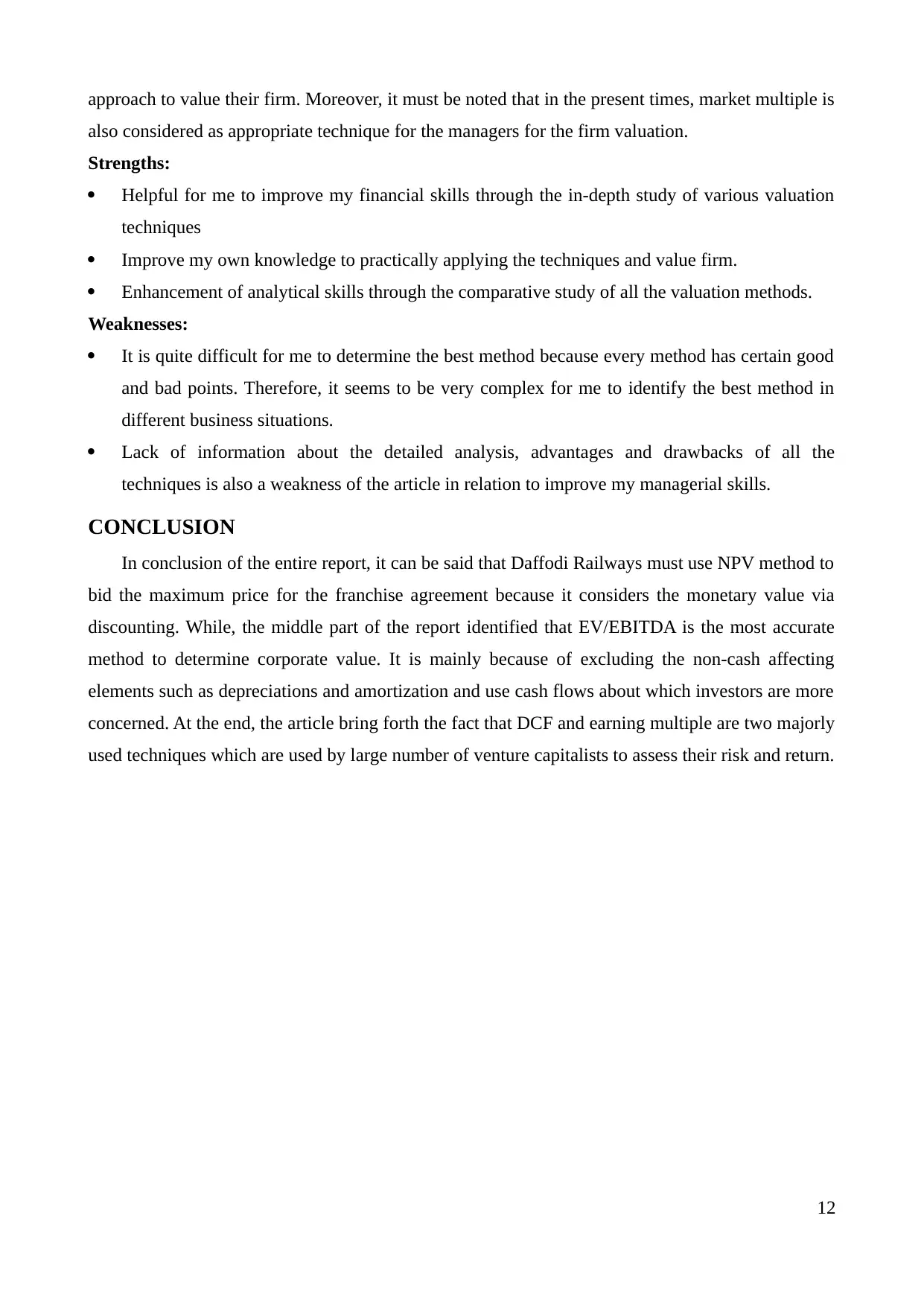
approach to value their firm. Moreover, it must be noted that in the present times, market multiple is
also considered as appropriate technique for the managers for the firm valuation.
Strengths:
Helpful for me to improve my financial skills through the in-depth study of various valuation
techniques
Improve my own knowledge to practically applying the techniques and value firm.
Enhancement of analytical skills through the comparative study of all the valuation methods.
Weaknesses:
It is quite difficult for me to determine the best method because every method has certain good
and bad points. Therefore, it seems to be very complex for me to identify the best method in
different business situations.
Lack of information about the detailed analysis, advantages and drawbacks of all the
techniques is also a weakness of the article in relation to improve my managerial skills.
CONCLUSION
In conclusion of the entire report, it can be said that Daffodi Railways must use NPV method to
bid the maximum price for the franchise agreement because it considers the monetary value via
discounting. While, the middle part of the report identified that EV/EBITDA is the most accurate
method to determine corporate value. It is mainly because of excluding the non-cash affecting
elements such as depreciations and amortization and use cash flows about which investors are more
concerned. At the end, the article bring forth the fact that DCF and earning multiple are two majorly
used techniques which are used by large number of venture capitalists to assess their risk and return.
12
also considered as appropriate technique for the managers for the firm valuation.
Strengths:
Helpful for me to improve my financial skills through the in-depth study of various valuation
techniques
Improve my own knowledge to practically applying the techniques and value firm.
Enhancement of analytical skills through the comparative study of all the valuation methods.
Weaknesses:
It is quite difficult for me to determine the best method because every method has certain good
and bad points. Therefore, it seems to be very complex for me to identify the best method in
different business situations.
Lack of information about the detailed analysis, advantages and drawbacks of all the
techniques is also a weakness of the article in relation to improve my managerial skills.
CONCLUSION
In conclusion of the entire report, it can be said that Daffodi Railways must use NPV method to
bid the maximum price for the franchise agreement because it considers the monetary value via
discounting. While, the middle part of the report identified that EV/EBITDA is the most accurate
method to determine corporate value. It is mainly because of excluding the non-cash affecting
elements such as depreciations and amortization and use cash flows about which investors are more
concerned. At the end, the article bring forth the fact that DCF and earning multiple are two majorly
used techniques which are used by large number of venture capitalists to assess their risk and return.
12
⊘ This is a preview!⊘
Do you want full access?
Subscribe today to unlock all pages.

Trusted by 1+ million students worldwide
1 out of 13
Related Documents
Your All-in-One AI-Powered Toolkit for Academic Success.
+13062052269
info@desklib.com
Available 24*7 on WhatsApp / Email
![[object Object]](/_next/static/media/star-bottom.7253800d.svg)
Unlock your academic potential
Copyright © 2020–2025 A2Z Services. All Rights Reserved. Developed and managed by ZUCOL.



